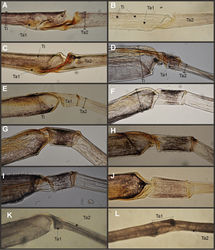Priasthenopus
| Notice: | This page is derived from the original publication listed below, whose author(s) should always be credited. Further contributors may edit and improve the content of this page and, consequently, need to be credited as well (see page history). Any assessment of factual correctness requires a careful review of the original article as well as of subsequent contributions.
If you are uncertain whether your planned contribution is correct or not, we suggest that you use the associated discussion page instead of editing the page directly. This page should be cited as follows (rationale):
Citation formats to copy and paste
BibTeX: @article{Molineri2015ZooKeys, RIS/ Endnote: TY - JOUR Wikipedia/ Citizendium: <ref name="Molineri2015ZooKeys">{{Citation See also the citation download page at the journal. |
Ordo: Ephemeroptera
Familia: Polymitarcyidae
Name
Priasthenopus Molineri & Salles & Peters, 2015 gen. n. – Wikispecies link – ZooBank link – Pensoft Profile
- Asthenopus (partim) Domínguez 1988[1]: 21; Hubbard and Domínguez 1988[2]: 207.
Type species
Asthenopus gilliesi Dominguez, 1988 (original designation).
Species included
Priasthenopus gilliesi (Dominguez), 1988 comb. n.
Diagnosis
Priasthenopus gen. n. presents seven autapomorphies in our cladistic analysis (Appendix 2), six are variations in continuous characters (e.g., stoutter penis lobe and larger thumb) and the seventh is the presence of a short closed cleft between the aforementioned structures. This genus can be distinguished from the other by the following combination of characters: 1) ratio length male FW/foreleg = 1.6–2.0; 2) first tarsal segment subquadrate not fused with tibia (Fig. 20E); 3) pronotum width/length ratio: 2.1–2.5 (male), 2.6 (female); 4) 5–10 marginal intercalary veins present on the margin of FW (Figs 8F, H), about as long as the distance between longitudinal veins in male, slightly longer in female, HW without marginal intercalaries; 5) male FW with 1 cross vein between Rs and MA basal to Rs fork (2 in female); 6) vein MP1 basally free (types from Uruguay and specimens from Colombia, Fig. 8D) or tending to fuse, although not completely, with MP2 (in specimens from Bolivia, Fig. 8E), IMP basally free; 7) median remnant of styliger plate rectangular thin and convex posteriorly, pedestals rectangular (Fig. 8A); 8) ratio total length/basal width of forceps 6.3–7.3 (Fig. 8A); 9) penes relatively short with a similar width along their length, strongly curved, without apical spine or spine very slightly marked as a subapical indentation, thumb rounded (Figs 8A–C); 10) female sternum VIII with well distinguishable anteromedian sockets (Figs 8J); 11) eggs with relatively large polar caps formed by 14–16 long threads (Fig. 8K), chorion loosely covered by medium-sized and small circular plates (Fig. 8L).
Male imago. Length (mm): body, 5.0–8.0; forewing, 5.7–8.4; hind wing, 2.6–3.9; foreleg, 3.1–4.5; cerci, 19.0–25.0. Pronotum width/length: 2.1–2.5. Wings (Figs 8D–G). FW with 5–10 marginal intercalary veins (Fig. 8F), each imv is about as long as the distance between corresponding longitudinal veins; vein MP2 basally free (Fig. 8D) or base directed towards MP1 (but not completely fused with it, Fig. 8E); IMP basally free; 1 cross vein present between Rs and MA basal to Rs fork. HW without marginal intercalaries (Fig. 8G). Legs. Forelegs about half the length of FW, middle and hind legs reduced in length and poorly sclerotized but with all the segments present and distinguishable. Genitalia (Figs 8A–C): median remnant of styliger plate rectangular, thin and convex posteriorly, pedestals rectangular and relatively small (Fig. 8A); 1-segmented forceps, ratio total length/basal width 6.3–7.3 (Fig. 8A); penes (Figs 8A–C) relatively short with a similar width along their length, strongly curved medially, and without apical spine. Cerci long and well developed, terminal filament extremely reduced as common in the family.
Female adult. Length (mm): body, 6.5; FW, 8.9; HW, 3.3; cerci, 1.5. Pronotum ring-like. Wing venation (Figs 8H–I) similar to male except FW with 2 cross vein between Rs and MA basal to Rs fork (arrows in Fig. 8H). Abdominal sternum 8 with anteromedian pair of small sockets (Fig. 8J). Cerci short, about 0.2 the length of FW.
Eggs (Figs 8K–L). Length, 240–275 µ; width, 150–165 µ. Two large polar caps (maximum width, 140–185 µ), formed by 14–16 very long coiled threads. The caps are as wide as or wider than the egg. Chorionic surface with medium sized and small subcircular disks.
Etymology
Arbitrary combination of letters.
Discussion
Treating this sole species in a new genus, distinct from Asthenopus is justified by its phylogenetic position (sister to the clade Povilla-Asthenopus). The other possibility to fit taxonomy to phylogeny would be to synonymize the entire clade (including Povilla and Languidipes besides gilliesi) in Asthenopus. This is the scheme apparently presented by Kluge (2004)[3] but this seems inadequate to us because of relatively large morphological gaps between the groups (including characters from eggs, nymphs and adults of both sexes). Furthermore, we tested Priasthenopus gilliesi position considering the hypotethical situation that its nymphs (still unknown) be identical to Asthenopus s.s., since male genitalia of both groups are similar. Even so, there were no changes in the resulting tree. The description of female adults and eggs is an original contribution of this work that gives additional diagnostic characters to genus level.
Original Description
- Molineri, C; Salles, F; Peters, J; 2015: Phylogeny and biogeography of Asthenopodinae with a revision of Asthenopus, reinstatement of Asthenopodes, and the description of the new genera Hubbardipes and Priasthenopus (Ephemeroptera, Polymitarcyidae) ZooKeys, (478): 45-128. doi
Images
|
Other References
- ↑ Domínguez E (1988) Asthenopus gilliesi sp. n. y su importancia en la taxonomía de la subfamilia Asthenopodinae (Ephemeroptera: Polymitarcyidae). Anales del Museo de Historia Natural de Valparaíso 19: 21–26.
- ↑ Hubbard M, Dominguez E (1988) Synonymy of the neotropical mayfly genera Asthenopus and Asthenopodes (Ephemeroptera : Polymitarcyidae : Asthenopodinae). The Florida Entomologist 71: 207–210. doi: 10.2307/3495369
- ↑ Kluge N (2004) The phylogenetic system of Ephemeroptera. Kluwer, 442 pp.

